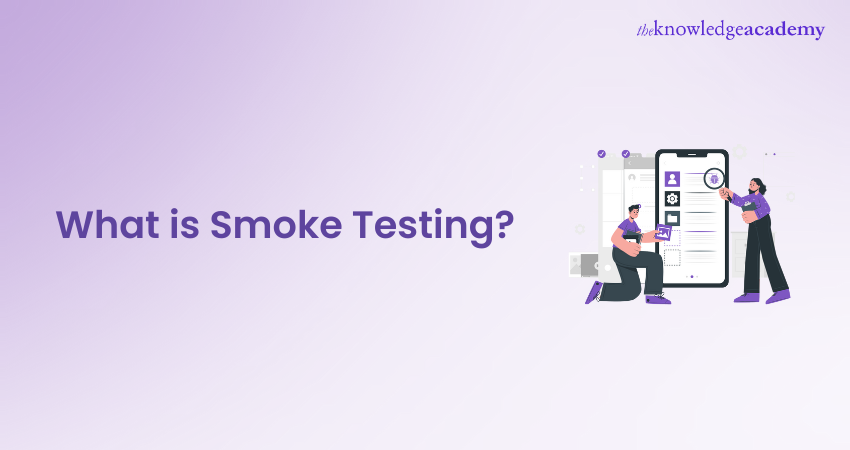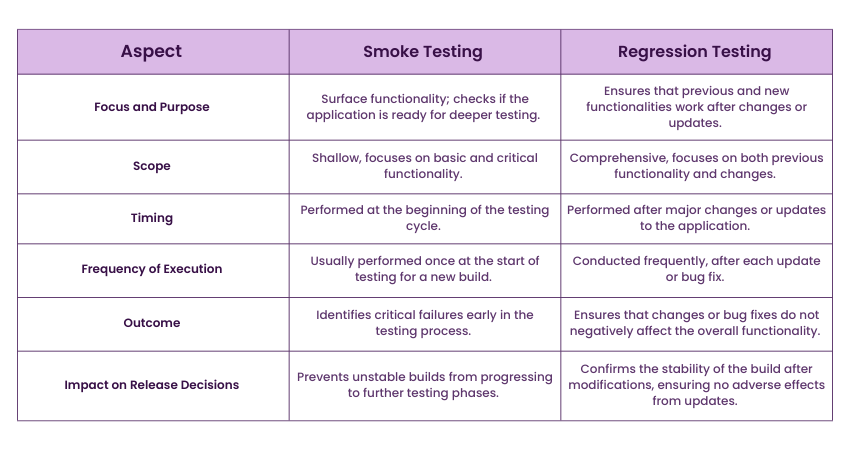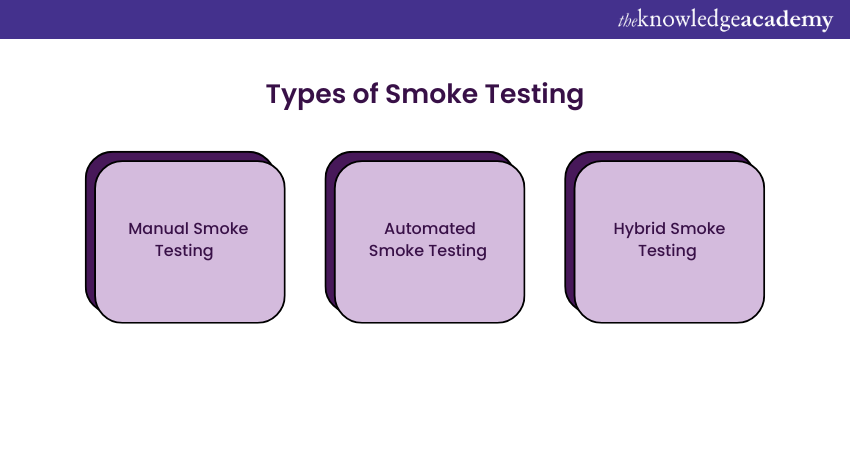We may not have the course you’re looking for. If you enquire or give us a call on +65 6929 8747 and speak to our training experts, we may still be able to help with your training requirements.
Training Outcomes Within Your Budget!
We ensure quality, budget-alignment, and timely delivery by our expert instructors.

Smoke Testing in Software Testing is a fundamental process that ensures the initial viability of Software Builds. As an essential preliminary step in the testing phase, Smoke Testing serves as a vital quality assurance technique. This method plays a crucial role in determining whether a Software Build is stable enough to proceed with further testing phases.
According to Glassdoor, the average gross salary of a Software Tester in the UK is about £36,491 annually. If you are interested in pursuing this career, then understanding testing procedures like Smoke Testing is vital. That is what this blog is all about. In this blog, you will learn what is Smoke Testing in Software Testing, its importance and benefits and how to perform it. Let’s dive in to learn more!
Table of Contents
1) What is Smoke Testing in Software Testing?
2) Characteristics of Smoke Testing
3) Goal of Smoke Testing
4) Types of Smoke Testing
5) How to Perform Smoke Testing in Software Testing?
6) Benefits of Smoke Testing
7) Disadvantages of Smoke Testing
8) Conclusion
What is Smoke Testing in Software Testing?
Smoke Testing is an initial evaluation in Software Testing conducted on a Software Build to determine its stability for further testing. This phase employs basic tests to identify significant defects or issues that could hinder the Software's functionality. By taking place early in the testing cycle, Smoke Testing enables the quick detection of problems before progressing to more complex testing procedures.
"Smoke" metaphorically represents detecting potential critical issues before they escalate into larger problems. Smoke Testing is a crucial quality checkpoint, ensuring that a Software Build meets the necessary stability standards to advance in the testing process. This approach saves time and enhances overall Software quality by addressing significant flaws early on.
Smoke Testing Examples
There are several types of Smoke Testing tailored to specific use cases. The three most common types are Integration, Acceptance, and System Testing.
Integration Testing
Integration Testing is essential whenever new modules are added to your Software. This type of testing can be performed on two modules at a time or on all modules simultaneously.
Acceptance Testing
Acceptance Testing is crucial before releasing a build to QA. This testing verifies that any new functions in the building work as intended.
System Testing
System Smoke Testing evaluates performance at the system level, allowing you to see how workloads interact with your underlying systems.
Difference Between Smoke Testing and Regression Testing
Smoke testing and Regression testing differ primarily in scope and frequency. Here is a detailed table curated to help you understand the difference between the two:

Characteristics of Smoke Testing
Smoke Testing is an initial testing process used to determine whether the basic functionalities of a Software Build are working correctly. Here are some key characteristics of Smoke Testing:
a) Quick Execution: Smoke tests are designed to run quickly, providing prompt feedback on the Software’s stability.
b) Non-exhaustive: These tests focus on the most critical functionalities, rather than covering every possible scenario.
c) Automated: Smoke tests are often automated to ensure they can be run frequently and consistently.
d) Self-scoring: Like other automated tests, smoke tests should be able to score themselves, indicating pass or fail without manual intervention.
e) Broad Coverage: They provide extensive coverage across the system to ensure that significant components function as expected.
f) Scripted and Documented: Smoke tests should be well-documented and scripted to ensure repeatability and reliability.
Smoke Testing helps catch major issues early in development, saving time and resources by identifying problems before more detailed testing begins.
Goal of Smoke Testing
The goals of Smoke Testing are:
a) Resource Efficiency: Avoid wasting resources on extensive testing if the core functions aren’t working correctly.
b) Time Management: Save time by identifying critical issues early, allowing development teams to address significant concerns promptly.
c) Objective Decision-Making: Provide a clear and unbiased framework for determining whether a Software Build is ready for more in-depth testing or needs immediate fixes.
d) Continuous Integration Support: Ensure that each new build meets basic quality standards before being integrated into the larger codebase, supporting the continuous integration process.
e) Effective Communication: Offer quick feedback on the build’s stability to aid effective communication between development and testing teams.
Types of Smoke Testing
Smoke Testing is of three types, which include:

Manual Smoke Testing
a) Test cases are written, developed, and updated manually by testers
b) High-priority test cases are executed to check for defects
c) Helps understand the practical functionality of the app before final production
Automated Smoke Testing
a) Uses tools like PhantomJS and Selenium to automate test cases
b) Faster and more efficient, providing immediate feedback on builds
c) Ideal for repetitive tasks and often used alongside regression testing
Hybrid Smoke Testing
a) Combines manual and automated testing approaches
b) Testers write and automate test cases, using tools to speed up the process
c) Benefits from both methods to ensure smooth application performance
Master the art of seamless software quality with our Software Testing And Automation Training – Sign up now!
How to Discussing the Types of Smoke Testing?
Performing Smoke Testing involves a systematic approach to quickly assess a Software Build's stability. Let’s explore the steps to conduct Smoke Testing in Software Testing effectively:
1) Obtain the Build: Acquire the latest Software Build from the development team that needs to be tested.
2) Identify key features: Determine the critical functionalities and core features of the software that should be included in the Smoke Testing.
3) Create test cases: Develop a set of test cases that target the identified critical functionalities. These test cases should cover basic operations and key user interactions.
4) Execute the tests: Run the prepared test cases on the Software Build. The focus here is not on exhaustive testing but on verifying that the essential features are functioning without major issues.
5) Analyse the results: Evaluate the outcomes of the test cases. If the Build passes all the smoke tests, it indicates that the software is stable enough to proceed to more comprehensive testing. The Build might need further fixes before retesting if any critical defects are detected.
6) Decision making: Based on the results, make an informed decision about the Software Build's stability. If it passes the smoke tests, it can move forward in the testing process. If it fails, it should be sent back to the development team for necessary adjustments.
7) Perform documentation: Document the results of the Smoke Testing process. This record can help as a reference for future testing cycles and collaborations within the team.
8) Collaborate with others: In cases where the Build fails the smoke tests, collaborate with the development team to address the identified issues. Repeat the Smoke Testing process once the necessary fixes are implemented to ensure the Build's stability.
By following these steps, you can efficiently execute Smoke Testing as a preliminary quality assurance measure. It allows you to quickly identify major defects and determine whether a Software Build is ready for further, more comprehensive testing phases.
Master performance testing with our JMeter Training. Sign up today!
Benefits of Smoke Testing in Software Testing
Smoke Testing offers several advantages within the Software Development and Testing process. Here are the key benefits of incorporating Smoke Testing in Software Testing:
a) Early Detection of Major Issues: Smoke tests conducted at the early stages of development can identify and prevent significant problems.
b) Time and Cost Efficiency: Quick and efficient smoke tests save time and money by halting further testing if issues are detected.
c) Quick Assessment of Application Stability: The primary goal is to determine if the Software is stable enough to proceed with further development.
d) Identification of Critical Failures Before Extensive Testing: Developers can catch major issues before handing the application to the QA team for more thorough testing.
e) Increased Confidence in Build Quality: Ensures the Software is released in a high-quality state, boosting confidence in the build.
Disadvantages of Smoke Testing
While having its pros, Smoke Testing also has its cons. Here are the disadvantages of Smoke Testing:
a) Limited Test Coverage: Only the most critical features are tested, leaving other areas unchecked.
b) Potential for False Positives: May identify issues that aren’t actual problems, leading to wasted time.
c) Reliance on Predefined Test Cases: Not all test cases in a suite are used, so some problems may go unnoticed.
d) Not a Substitute for Comprehensive Testing: Comprehensive testing is necessary to identify most issues that Smoke Testing alone cannot solve.
e) May Miss Minor Defects or Edge Cases: Since only critical features are tested, minor defects or edge cases might be overlooked.
Elevate your software expertise with our Certified Software Testing Professional (CSTP) Course - Sign up now!
Conclusion
Incorporating Smoke Testing in Software Development offers a strategic advantage by swiftly identifying major defects. Embracing this practice ensures enhanced Software stability, quality, and user satisfaction, making it an indispensable tool in modern Software Testing. Additionally, conducting other testing like Regression, Performance, and Security Testing is also essential for maintaining quality standards before releasing the product.
Gain the deep knowledge of testing process with our ISTQB Advanced Level Test Manager – Join now!
Frequently Asked Questions

User Acceptance Testing (UAT) ensures the software meets user requirements and is ready for production. Smoke testing, on the other hand, is a preliminary test to check basic functionality and stability before deeper testing begins.

A smoke test in Jira is a preliminary check to ensure that a Software Build's basic functionalities are working correctly. It helps identify major issues early, ensuring the build is stable enough for more detailed testing.

The Knowledge Academy takes global learning to new heights, offering over 30,000 online courses across 490+ locations in 220 countries. This expansive reach ensures accessibility and convenience for learners worldwide.
Alongside our diverse Online Course Catalogue, encompassing 19 major categories, we go the extra mile by providing a plethora of free educational Online Resources like News updates, Blogs, videos, webinars, and interview questions. Tailoring learning experiences further, professionals can maximise value with customisable Course Bundles of TKA.

The Knowledge Academy’s Knowledge Pass, a prepaid voucher, adds another layer of flexibility, allowing course bookings over a 12-month period. Join us on a journey where education knows no bounds.

The Knowledge Academy offers various Software Testing Courses, including the Software Testing Black Belt Course, Software Testing Green Belt Course, and so on. These courses cater to different skill levels, providing comprehensive insights into Software Testing Case Studies.
Our Business Analysis Blogs cover a range of topics related to Software Testing, offering valuable resources, best practices, and industry insights. Whether you are a beginner or looking to advance your Software Testing skills, The Knowledge Academy's diverse courses and informative blogs have got you covered.







 Top Rated Course
Top Rated Course




 If you wish to make any changes to your course, please
If you wish to make any changes to your course, please


